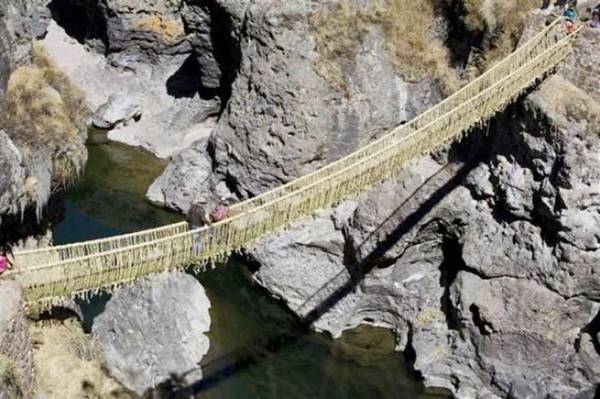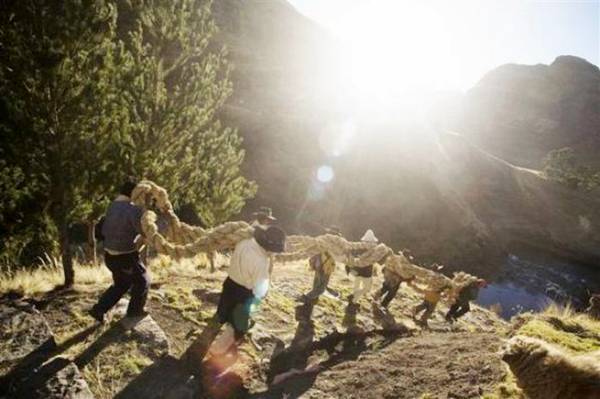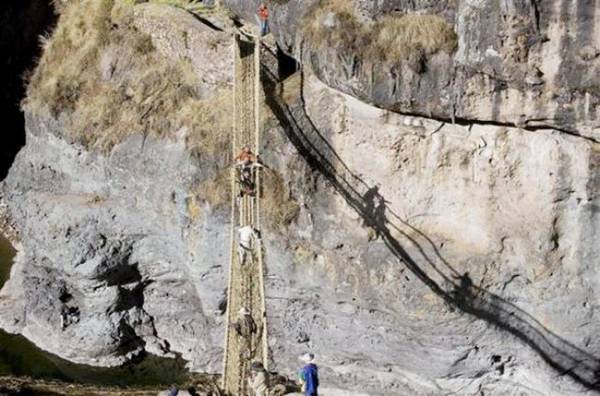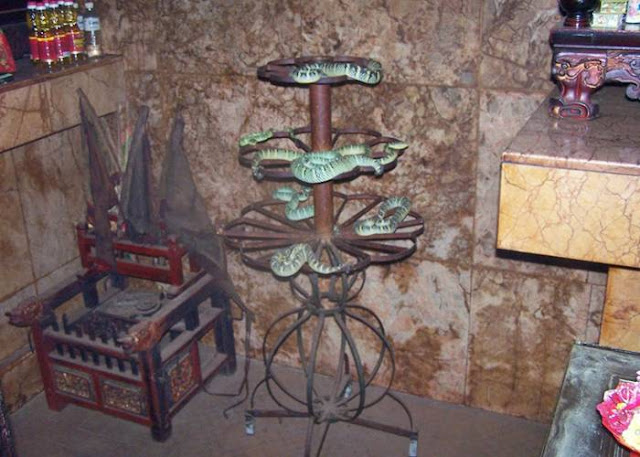Wuppertal Schwebebahn
"Schwebebahn" redirects here. For the funicular railway in Dresden, see Schwebebahn Dresden.Wuppertal Schwebebahn .

Info
Locale Wuppertal, Germany
Transit type suspended monorail
Number of lines 1
Number of stations 20
Daily ridership 72,000
Operation
Began operation March 1, 1901
Operator(s) Wuppertaler Stadtwerke (WSW)
Technical System length 13.3 kilometres (8.3 miles)
The Wuppertal Schwebebahn is a suspended monorail in Wuppertal, Germany. Its full name is the “Eugen Langen Monorail Suspension Railway” (Einschienige Hängebahn System Eugen Langen). Designed by Eugen Langen, who originally planned to build it in Berlin, it was built in 1900, opened in 1901 and is still in use today as a local transport system in the city. It is the oldest monorail system in the world.
The suspension railway travels along a route 13.3 kilometres long, about 12 metres above the surface of the river Wupper between Oberbarmen and Sonnborner Straße (10 km) and approximately 8 m above the city streets, between Sonnborner Straße and Vohwinkel (3.3 km). At one point the railway crosses the A46 motorway. The entire trip takes about 30 minutes.
The Schwebebahn operates within the VRR transport association and accepts tickets issued by the VRR companies.
History
The Wuppertal Schwebebahn had one model: in 1824, Henry Palmer of England first presented the world with a railway system which differed from all previous construction forms. It was basically a small suspension railway on which suspended carriages were drawn by horses. Friedrich Harkort, a famous German industrialist and politician, loved the idea. He had a system of this type built as a trial in 1826 and ran it on the grounds of what is today the tax office at Elberfeld. He tried to interest the public in his scheme.
On 9 September 1826, the town councillors of Elberfeld met to discuss the use of a “Palmer’s Railway” from the Ruhr to the river Wupper, mainly for the purpose of supplying the growing city with cheaper coal. Friedrich Harkort inspected the projected route with a surveyor and a member of the town council. The railway was to go from Elberfeld to Hinsbeck or from Elberfeld to Langenberg. The plan never went ahead, however, due to the owners of various pits who had not been included in it and felt disadvantaged at having been left out.
The suspension railway which was finally built was planned and tested by the engineer Carl Eugen Langen in Cologne during the 1880s. In 2003, the Rhenish Heritage Office (Rheinische Amt für Denkmalpflege des Landschaftsverbandes Rheinland or LVR) published a press report announcing the discovery of an original section of the test route of the Wuppertal Schwebebahn.
Construction on the actual Wuppertal Schwebebahn began in 1898. On 24 October 1900, William II, German Emperor participated in a monorail trial run.
In 1901, after a construction period of about three years overseen by the government’s master builder, Wilhelm Feldmann, the railway came into operation. It opened in sections: the line from Kluse to Zoo/Stadion opened on March 1, the line to the western terminus at Vohwinkel opened on 24 May, while the line to the eastern terminus at Oberbarmen did not open until 27 June 1903.Around 19,200 tonnes of steel were worked to produce the supporting frame and the train stops. Construction cost 16 million Goldmark. Since its first opening, the railway has closed once due to severe damage from World War II, but managed to open as early as 1946.
[edit] Current modernisationThe Wuppertal Schwebebahn was considered one of the safest means of transport in the world, carrying up to 75,000 passengers a day through the city. Since 1997, the supporting frame has been largely modernised, and a large number of train stops have been reconstructed and brought up to date technically. The “Kluse” stop, at the theatre in Elberfeld, had been destroyed during the Second World War; this too was reconstructed during the modernisation. Work was planned to be completed in 2001; however a serious accident took place in 1999 which left five people dead and 47 injured. This, along with delivery problems, meant that the completion date was delayed. In recent years (2004), the cost of the reconstruction work has nearly doubled from €250 million to €390 million.
Since 2004, many of the train stops have been fitted with CCTV cameras.





Accidents
15 January 1917
On that day a train rear ended another train that had stopped unexpectedly in front of it between Oberbarmen and Wupperfeld, causing the trailing car of the stopped train to fall off of the track. There were two minor injuries.Subsequently, a safety device was developed to make derailments nearly impossible.
21 July 1950
The Althoff Circus orchestrated a publicity stunt by putting an elephant by the name of Tuffi on the train at the Alter Markt station. Tuffi became upset shortly into the ride, crashed through the left side of the car and fell into the river Wupper below. The elephant, two journalists, and one passenger received minor injuries. Both the operator and the circus director were fined after the incident. To this day, the wall of a building at the location of the event (in-between the stations Alter Markt and Adlerbrücke) shows a painting of a jumping elephant.
11 September 1968
On that day, a truck crashed into a pillar and caused a section of track to fall. There were no trains in the area at the time. This incident led to the use of concrete walls in pillar anchors.
25 March 1997
A technical malfunction caused a rear-end collision in Oberbarmen station between a structure train and the Kaiserwagen. There were 14 injuries, but no derailment.
12 April 1999
The only fatal accident of the Schwebebahn Wuppertal occurred close to the Robert-Daum-Platz station during maintenance work in the early morning hours of April 12th, 1999. Workers forgot to remove a metal claw from the track on completion of scheduled night work. The first train of the day heading east hit the claw at a speed of around 50 km/h, then derailed and crashed down about 10 meters into the river Wupper, killing 5 passengers and leaving 49 injured. The salvage operation took 3 days and nights to complete. 8 weeks after the accident the Schwebebahn went back into operation. The financial damage from the accident was in the vicinity of 8 million Deutsche Mark. The judicial proceedings following the accident highlighted that the disaster was not caused through technical defects or system failure, but through negligence by workers having fallen behind in their work schedule during the preceding night, and abandoning the work site hastily only 10 minutes before the train departed from the depot. Contributing to the circumstances was a lack of control of their activities by site supervisors. The Works Manager in charge of safety and the workers dealing with the steel claw at the time were acquitted from all charges by the District Court of Wuppertal. The site supervision personnel, having neglected their duties of control, were sentenced for involuntary manslaughter in 5 cases and bodily injury caused by negligence in 37 cases, but let off on probation with verdict 4 StR 289/01 dated 31 January 2002.
5 August 2008
Schwebebahn accident of 5 August 2008, near the Hammerstein stationThe Schwebebahn collided with a crane truck making deliveries under the track, causing a 10-meter long tear in the floor of one of the cars. The truck driver was seriously injured,and the train driver and some passengers were treated for shock.






































































